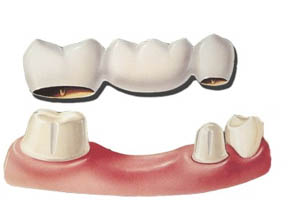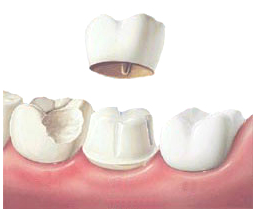Bridges & Crowns
When you’ve lost a tooth that shows when you smile, it can be emotionally traumatic. However, new technology enables us to make a tooth replacement that looks and feels like the real thing.
What is a dental bridge?
 A dental bridge is a false tooth or teeth, known as a pontic, which is fused between two porcelain crowns to fill in the area left by a missing tooth or teeth. The two crowns holding it in place that are attached onto your teeth on each side of the false tooth. This is known as a fixed bridge. This procedure is used to replace one or more missing teeth. Fixed bridges cannot be taken out of your mouth as you might do with removable partial dentures.
A dental bridge is a false tooth or teeth, known as a pontic, which is fused between two porcelain crowns to fill in the area left by a missing tooth or teeth. The two crowns holding it in place that are attached onto your teeth on each side of the false tooth. This is known as a fixed bridge. This procedure is used to replace one or more missing teeth. Fixed bridges cannot be taken out of your mouth as you might do with removable partial dentures.
Bridges can reduce your risk of gum disease, help correct some bite issues and even improve your speech. Bridges require your commitment to serious oral hygiene, but will last as many years.
Who is a candidate for dental bridges?
If you have missing teeth and have good oral hygiene practices, you should discuss this procedure with Dr. Scroggins If spaces are left unfilled, they may cause the surrounding teeth to drift out of position. Additionally, spaces from missing teeth can cause your other teeth and your gums to become far more susceptible to tooth decay and gum disease.
Crowns
 As we get a little older, our teeth begin to change and are prone to decay.
As we get a little older, our teeth begin to change and are prone to decay.
There are many possible reasons for this change in your smile. These reasons can include bruxism (teeth grinding), general decay, cracked fillings, root canals, and many others. If your tooth is beyond repair with a filling material, we may recommend that the best viable option to save the tooth is a full crown. The reasons for this type of restoration in a badly damaged tooth are durability, cosmetic appearance, and overall support of the chewing function.
Types of Crowns
If we decide that you are in need of a full crown, there are a few different options for the repair of your tooth. These options include a full porcelain crown, a porcelain fused to metal or gold crown, or a full gold crown. We will make the determination as to which of these options is the most appropriate for your situation. You can be comfortable in knowing that your new tooth will be virtually unnoticeable and will flawlessly complement the rest of your smile.
Procedure
When we have decided to go ahead with a full crown restoration, we will set aside 2-3 appointments for the entire process. Although the majority of crowns are completed in two visits, there is sometimes a need for a third visit to ensure a proper fit.
The procedure begins with the removal of all decay in the tooth. Once we have removed the decay, we will take an impression of the tooth. This impression will be sent to our lab where your new restoration will be crafted. While this new tooth is created, we will provide you with a temporary restoration. Our temporary restorations will resemble your natural teeth so that you can continue with your daily life without worrying about a missing or incompatible tooth.
During your second visit to the office, we will proceed with the placement of your final restoration. This crown will be fitted comfortably into the mouth. We will make every effort to ensure that the new tooth feels exactly like one of your natural teeth. The final step in the process is to cement the crown into your mouth, leaving you with a beautifully restored smile.
Crown Lengthening
When decay occurs below the gumline, it may be necessary to remove a small amount of bone and gum tissue. Dr. Scroggins may ask for this procedure before he or she makes a new crown for your tooth.
Crown Lengthening procedures are done for both restorative dentistry and/or to improve the esthetics of your gum line. General practitioners often refer for crown lengthening procedures prior to restoration of broken or severely decayed teeth. This procedure adjusts the gum and bone level to expose more of the tooth so it can be restored.
Sometimes crown lengthening is done to improve a “gummy” smile because the teeth appear short. The teeth may actually be the proper length but excess gum tissue may be covering these teeth. During this procedure, excess gum and bone tissue is reshaped to expose more of the natural tooth.


